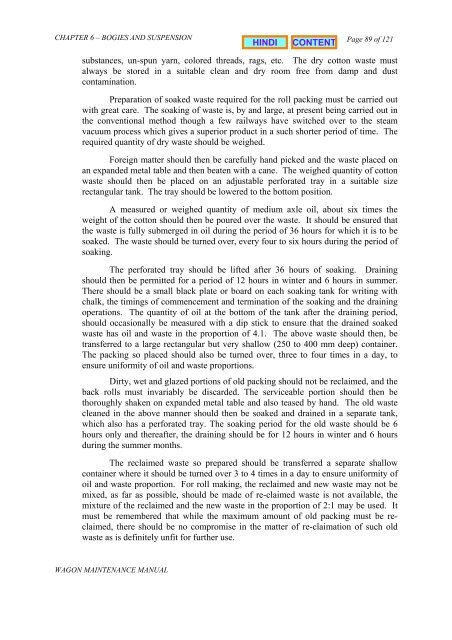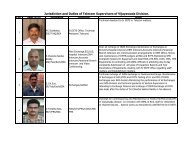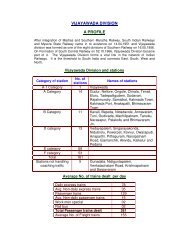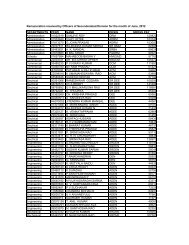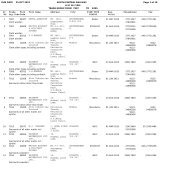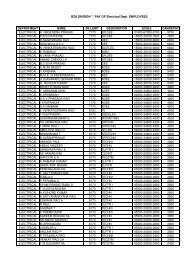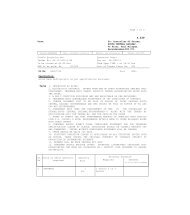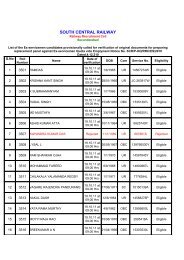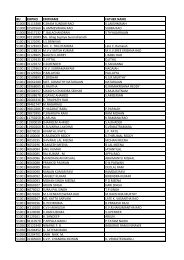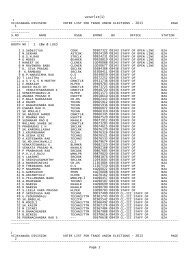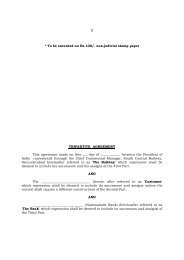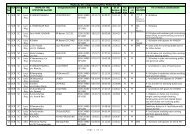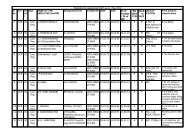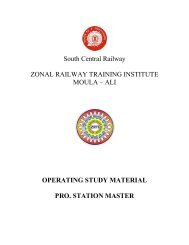BOGIES AND SUSPENSION - South Central Railway
BOGIES AND SUSPENSION - South Central Railway
BOGIES AND SUSPENSION - South Central Railway
You also want an ePaper? Increase the reach of your titles
YUMPU automatically turns print PDFs into web optimized ePapers that Google loves.
CHAPTER 6 – <strong>BOGIES</strong> <strong>AND</strong> <strong>SUSPENSION</strong><br />
WAGON MAINTENANCE MANUAL<br />
Page 89 of 121<br />
substances, un-spun yarn, colored threads, rags, etc. The dry cotton waste must<br />
always be stored in a suitable clean and dry room free from damp and dust<br />
contamination.<br />
Preparation of soaked waste required for the roll packing must be carried out<br />
with great care. The soaking of waste is, by and large, at present being carried out in<br />
the conventional method though a few railways have switched over to the steam<br />
vacuum process which gives a superior product in a such shorter period of time. The<br />
required quantity of dry waste should be weighed.<br />
Foreign matter should then be carefully hand picked and the waste placed on<br />
an expanded metal table and then beaten with a cane. The weighed quantity of cotton<br />
waste should then be placed on an adjustable perforated tray in a suitable size<br />
rectangular tank. The tray should be lowered to the bottom position.<br />
A measured or weighed quantity of medium axle oil, about six times the<br />
weight of the cotton should then be poured over the waste. It should be ensured that<br />
the waste is fully submerged in oil during the period of 36 hours for which it is to be<br />
soaked. The waste should be turned over, every four to six hours during the period of<br />
soaking.<br />
The perforated tray should be lifted after 36 hours of soaking. Draining<br />
should then be permitted for a period of 12 hours in winter and 6 hours in summer.<br />
There should be a small black plate or board on each soaking tank for writing with<br />
chalk, the timings of commencement and termination of the soaking and the draining<br />
operations. The quantity of oil at the bottom of the tank after the draining period,<br />
should occasionally be measured with a dip stick to ensure that the drained soaked<br />
waste has oil and waste in the proportion of 4.1. The above waste should then, be<br />
transferred to a large rectangular but very shallow (250 to 400 mm deep) container.<br />
The packing so placed should also be turned over, three to four times in a day, to<br />
ensure uniformity of oil and waste proportions.<br />
Dirty, wet and glazed portions of old packing should not be reclaimed, and the<br />
back rolls must invariably be discarded. The serviceable portion should then be<br />
thoroughly shaken on expanded metal table and also teased by hand. The old waste<br />
cleaned in the above manner should then be soaked and drained in a separate tank,<br />
which also has a perforated tray. The soaking period for the old waste should be 6<br />
hours only and thereafter, the draining should be for 12 hours in winter and 6 hours<br />
during the summer months.<br />
The reclaimed waste so prepared should be transferred a separate shallow<br />
container where it should be turned over 3 to 4 times in a day to ensure uniformity of<br />
oil and waste proportion. For roll making, the reclaimed and new waste may not be<br />
mixed, as far as possible, should be made of re-claimed waste is not available, the<br />
mixture of the reclaimed and the new waste in the proportion of 2:1 may be used. It<br />
must be remembered that while the maximum amount of old packing must be reclaimed,<br />
there should be no compromise in the matter of re-claimation of such old<br />
waste as is definitely unfit for further use.


